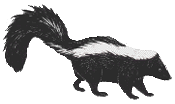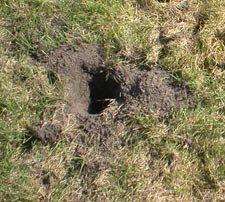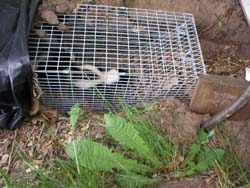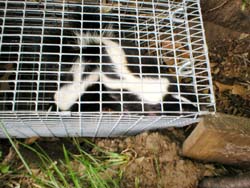|
|
SKUNK
REMOVAL
Skunk biology
Minnesota has 2 species of skunks, the stripped skunk and the spotted
skunk. Skunks are members of the weasel family and are omnivores.
Stripped skunks weight between 3-10# and are 20-32” in
length. Mating
occurs between February and March and after a 60 day gestation skunks
give birth to 3-5 young. Litters of 10 are possible. Skunks are
nocturnal but the babies can be seen out any time of the day along with
mother. In early winter, skunks den up and become inactive, but they do
not actually hibernate. Mid-winter warm spells bring them out for
hunting forays.  Several skunks (sometimes eight to 10) often occupy the
same den in winter, especially the females. Skunks can spray up to
15’
and babies have a 2’ range. Spotted skunks are very rare in
Minnesota
and only live in the southern corner of the state. Several skunks (sometimes eight to 10) often occupy the
same den in winter, especially the females. Skunks can spray up to
15’
and babies have a 2’ range. Spotted skunks are very rare in
Minnesota
and only live in the southern corner of the state.
Symptoms
The one tell tale
sign of skunks is smell!!!!!! Another sign is
sighting the babies or the mother. Skunks also like to burrow under
decks and porches. They will take over an old woodchuck den or just dig
a new one. Skunks will dig little cone shaped hole into your lawn
looking for grubs.
 Removal Removal
The removal all starts with a inspection. We will come out and
access the damage to identify the species doing the damage. Then we
will
set the appropriate traps to remove the animals. We will also recommend
habit modifications and exclusions available for your site. And give
you a cost to repair the damage. If the skunk has sprayed we can
deodorizes the area. All skunks are caught in live
traps,
but because we have no place to release them, all skunks are
euthanized.
 Exclusions Exclusions
A more permanent solution to a skunk problem is to use a exclusion
technique to permanently keep the skunks from burrowing under your
deck, shed or other structure. For this we use hardware cloth buried
into the ground and attached to the structure, this prevents the skunk
from burrowing
|

